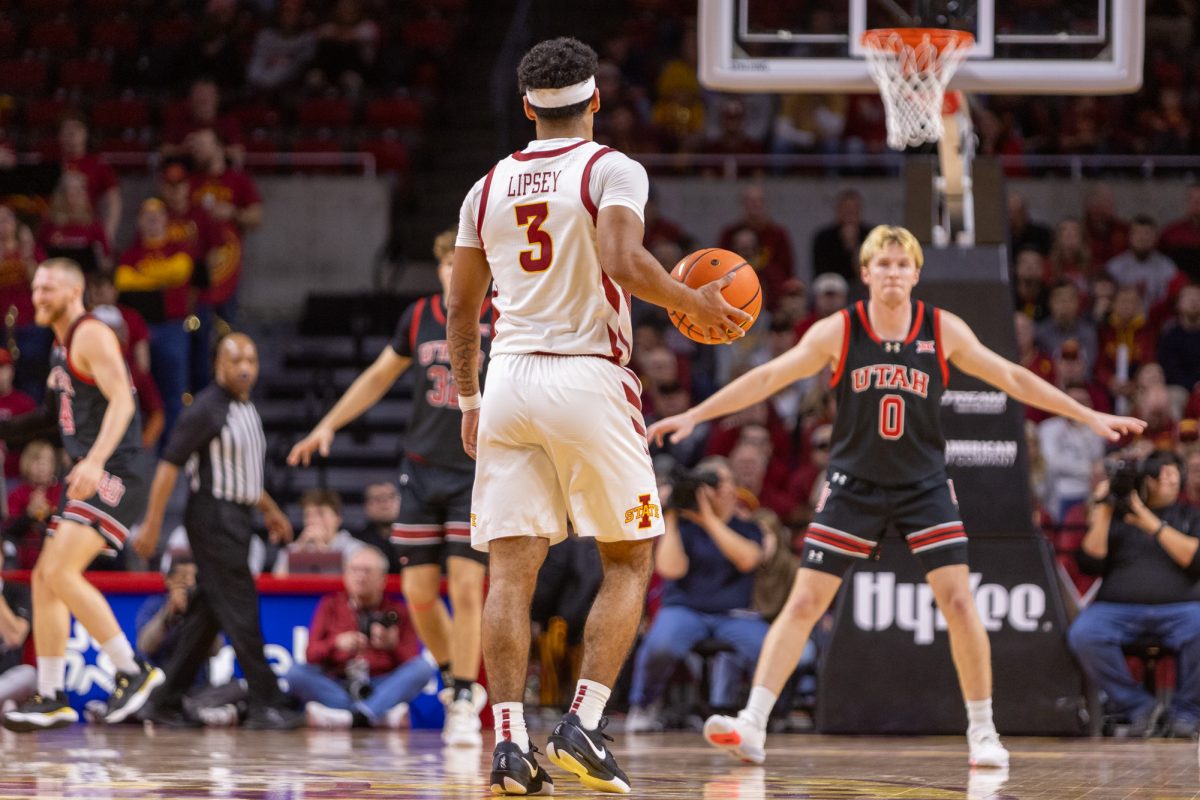Buckin’ broncos
April 25, 2007
The thump-thump of the drums from Ozzy Osbourne’s “Crazy Train” trails through the open-air arena. The sun is just about to dip below the horizon, making people shade their eyes to see a young man clad in Wrangler jeans wrapped in dusty chaps, a pair of worn leather cowboy boots and a straw hat that has seen its better days.
The cowboy lowers himself slowly onto an 1,800-pound Brahman bull that is trapped within the confines of a 5-by-10-foot bucking chute. The bull’s horns clank against the chute’s metal bars, as it struggles to free itself.
Meanwhile, the cowboy ties his leather-gloved fist into place, securing his grip for the ride to come. A nod of his head and the gate is flung open by two more cowboys in similar dress. Ozzy screams “Alllll Abooooard!” while the cowboy’s heels spur the bull’s sides, making the Brahman spin like a child’s top gone out of control. One hand high above his head, in perfect form, shifting his weight with each buck, the cowboy is in for the ride of his life.
Fans are on their feet, their claps and whistles keeping in time with the energy of the bull. A thunderous buzzer pierces the air, and the crowd goes wild as the cowboy dismounts, landing on the thick carpet of dirt on the arena floor. The rider stunned and lying on his side, a rodeo clown steps between him and the bull just in time, offering himself up as a distraction. The cowboy jumps up, grabs his hat and safely reaches the side of the arena.
The distraction, adorned in baseball cleats, a pair of oversized cutoff shorts clasped to rainbow-patterned suspenders and a plaid shirt, with his face painted as a circus clown, appears to be a playing a game of tag. Bullfighter and Brahman zigzag their way around the arena, teasing one another. Suddenly a gate swings open, which is the bull’s cue to exit and the bullfighter climbs the side of the arena until the next eight-second ride.
Rodeo: an American pastime. Just as American as baseball and apple pie.
American rodeo events began in the late 1800s when ranch hands needed some entertainment after a long day’s work, and they adapted Mexican horsemanship activities into a competition. On July 4, 1883, in Pecos, Texas, the first rodeo to charge admission and to offer prizes occurred. From that time on, rodeo morphed through exhibitions such as Buffalo Bill’s Wild West Show to the today’s modern day rodeo.
Today, young men all over the country are participating in this sport, including Shawn Culhane, junior in construction engineering.
Culhane grew up in rural Illinois watching his cousin ride at the county fair. He said his cousin was a big influence on him back then, and he still looks to him for guidance.
“I always wanted to ride bulls, and my parents wouldn’t let me,” Culhane said.
When Culhane made the transition to college, he decided this was his opportunity to begin the sport. He joined the ISU Rodeo Club and started riding bulls in August 2005 as a freshman.
Culhane said he is not the typical bull rider who was raised riding bulls, but, he pointed out, “It’s more mental. If you have a desire to do it, you’ll do it.”
Clint Dickes, a rodeo clown from Alden who recently provided consultation to the club and describes himself as a bullfighter, said he didn’t grow up in a family of bullfighters either. However, he had the desire to seek out the road to his dream.
Historically, rodeo clowns wore two hats: one as a “funny man” or clown to entertain the crowd, and one as a protector of the bull rider against the bull.
Dickes, who has been distracting and diverting bulls for riders such as Culhane for 14 years now, said his influence was his aunt, who was a barrel racer. He recalls watching her at rodeos, but what left the lasting impression on him were the rodeo clowns.
At the age of 3, Dickes said he would play rodeo with his dog and a barrel.
As a freshman in high school, his aunt gave him the name of a ranch owner in Oklahoma who taught him the ropes. Dickes said he spent every summer on the ranch.
“I learned by getting my butt kicked by longhorned bulls,” Dickes said.
Today, Dickes said, there are schools for cowboys to learn how to ride and fight bulls.
“You can teach someone to [ride bulls], but they have to have a passion for it,” Dickes said, then adding, “Even if you want to, your body still doesn’t want to let you.”
He compared bull riding and bullfighting to putting your hand on a hot burner, saying after you do it once, you have to retrain yourself not to be afraid.
While in Oklahoma, Dickes worked as a bullfighter for junior rodeos. He said once he began college, he started to become more businesslike about the sport.
Dickes said for about eight years, he spent approximately 230 days per year on the road. He lived out of a fifth-wheel truck and trailer traveling from rodeo to rodeo to places such as Madison Square Garden, N.Y., and Anaheim Pond, Calif.
Dickes, who has a minor in psychology from Ellsworth College, uses his knowledge of psychology in his sport. He describes several rodeo events as “one giant action-reaction.”
Whether the event is roping, bull riding, bronco riding or bullfighting, Dickes said the animals each have a mind of their own, and they are going to do whatever it is they want to do.
A bull rider or rodeo clown’s job is to master motor memorization, Dickes said.
Motor memorization results when one remembers how to react without thinking about it after many experiences. Dickes said after a perfect ride, bull riders should close their eyes and watch it in their minds, noting the movements so the next time their reactions will occur naturally.
“Your muscles basically react without you thinking about it then,” Dickes said.
To get the body to this point, a bull rider has to ride a lot, Dickes said. He said the first 80 to 100 bulls don’t even put a dent in a rider’s motor memorization.
“It takes a long time at first. The first time is like an infant taking their first step,” Dickes said.
In agreement with Dickes, Culhane said, “You just got to get on a lot, it takes some time. You’ve got to be consistent with it.”
Both Dickes and Culhane admit there is an obvious element of danger in their sport of choice.
“It’s kind of hard on the body,” Culhane said.
Aside from expected bumps and bruises, Culhane has been stepped on several times by bulls and has repeatedly landed on his right shoulder, causing him to take some time off to build the muscle strength again. In addition, Culhane said he has fractured ribs because of riding.
“Dislocating shoulders and bumps and bruises are just like everyday [occurrences],” Dickes said.
Dickes said his injuries list is long after 14 years: Two torn ACLs; a torn MCL in his left knee; a broken neck twice; a broken ankle; bruised and broken ribs; and many broken fingers and toes.
By far, Dickes’ scariest memory was waking up in a hospital helicopter in Webster City. Dickes said a bull cornered him and shoved him through the bottom two rungs of an arena fence. The roughly 12 inches that made up the gap was not nearly wide enough for a man of Dickes’ stature.
Even through the apparent danger of being a rodeo clown or bull riding, Culhane and Dickes claim they have good reasons to keep tempting fate.
“It’s such a rush, and it’s something I’ve always wanted to do,” Culhane said. He added that bull riders are probably a bit on the crazy side, although he has never thought of himself in those terms.
Dickes said his reward comes from times when he can divert a bull away from a cowboy that has been bucked off and isn’t quite aware of his surroundings yet. He said his goal is to never let the bull touch the rider.
“It’s just what I’ve always wanted to do. Every time I fight bulls, I’m living my dream,” Dickes said.
Culhane and Dickes readily admit the life of either bull riding or bullfighting can’t continue forever. Culhane said he wouldn’t want to sacrifice a job because of bull riding, and at some point, riders have to decide if it is worth it.
Although Dickes said as soon as he enters the arena, he feels he has reached something like a state of Zen – feeling calm and completely comfortable – he also realizes there will be an end to it. Dickes said he thinks he has a few more good years left of fighting and then plans to move on to the business side of rodeos by putting on shows and hauling bulls.
“I’ll never stop going,” Dickes said. “I’ll always have my hands in it somehow.”






